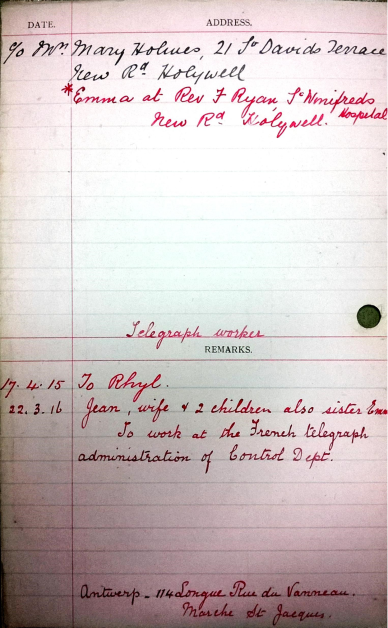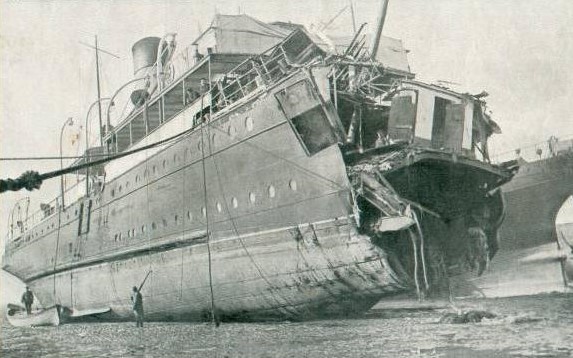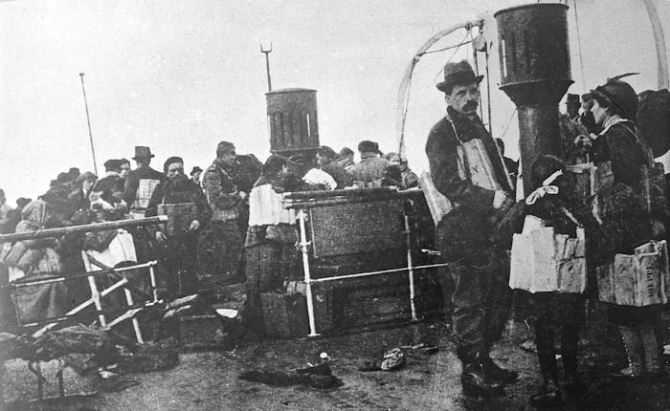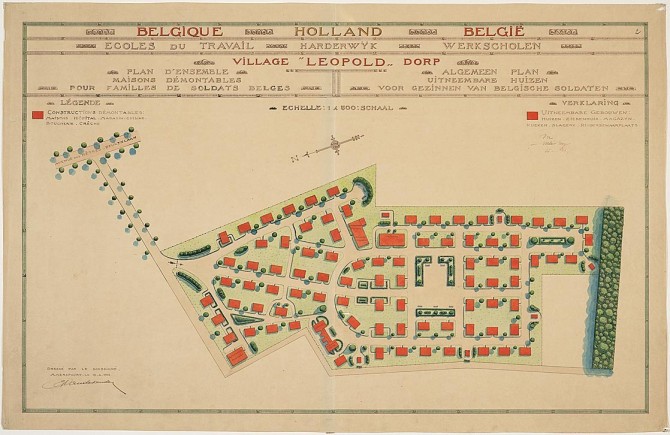The Family Cassimon and the Sinking of “The Sussex”
De Stem uit België (in French: L’Echo de Belgique) was a newspaper published in London during the First World War by E. H. Flor Prins and distributed widely throughout the UK. It became a valuable tool for displaced families of Belgian Refugees to contact each other or alert their families as to their whereabouts.
Two Refugee families who stayed in Rhyl used the columns of the newspaper to attempt to get messages to their loved ones.
The first is that of a doctor looking for news of his two daughters:
30/10/1914
“Dr. Janssens – De Wil, 2 East Parade, Rhyl, North Wales, verlangt nieuws zin dochters Rosalie en Isabelle.”
Unfortunately, we can find no further information about Dr. Janssens and we don’t know if he found his daughters. He is not listed in the National Archives – there is no registration card for him or Rosalie & Isabelle. A friend of the Refugees in Rhyl project will be searching the Rijksarchief in Brussels in April, so hopefully we can report more soon.
The second listing in De Stem uit België, a whole year later, gives us a very interesting and important story to tell about a major incident of the War. The head of the Cassimon family (Joannes / Jean / Jan Baptist) from Antwerp is using the newspaper to tell his family and friends that he, his sister Emma and his children are staying in the Refugee House at 2, East Parade in Rhyl.
1/10/1915
“Cassimon – De Kimp, Jan, kinderen en zuster Emma, uit Antwerpen, verblijven 2, East Parade, Rhyl (North Wales)”
What we found in the National Archives at Kew: Originally Jan, wife Clementine and his two children were placed with Mrs. Mary Holmes at 21, St. David’s Terrace, Holywell, and Jan’s sister Emma is “c/o” Rev Father. J. Ryan at St. Winefride’s in New Road in Holywell, but on April 19th, 1915 they all moved to Rhyl. Jan is listed as a “Telegraph Worker”. They left Rhyl on the 22nd of March, 1916.

In Flintshire Record Office as part of a document entitled “Reports re Belgian Refugees to close of October 1915” we found this information:
“Cassimon – This family removed to Rhyl – where the man found employment under the Government – some months ago.”
What happens to them after they leave Rhyl is shocking – Jan was moving his family to France to take up a position with the French Telegraph in the Control Department – although thankfully we found reports that they were safe…
The Sussex
After leaving Rhyl, Jan Baptist Cassimon, his wife Clementina, their two children and his sister Emma made their way to Folkestone to join the steam ship “The Sussex”. Sailing under a French flag, the Sussex had been built in 1896 by William Denny & Brothers of Dumbarton. She carried only civilians and post-bags, was unarmed and not part of the war effort.
During the First World War, shipping from Newhaven had been diverted to operate from Folkestone in order to free Newhaven for supplying British troops to the Western Front.
On the 24th of March, 1916, with our family on board, The Sussex set off from Folkestone to Dieppe. She left at 1.00pm on a calm sea. At around 3.00pm, she was torpedoed by a German submarine, being hit on the starboard side. The captain, M. Mouffet, had seen the wake of the torpedo approaching, and had tried to take evasive action. By turning the ship and acting as he did he certainly saved many lives – indeed he was awarded the Croix de la Légion d’Honneurs for his actions that day. Although the entire bow forward of the bridge was blown off, this manoeuvre avoided a hit to the centre of the ship. Some of the lifeboats were launched, but at least two of them capsized and many passengers were drowned. Of the 53 crew and 325 passengers, at least 50 were killed, although a figure of between 80 and 100 is also suggested, and there were over 80 injured. The wireless apparatus was damaged so it was not immediately possible for the ship to contact help.

Stories of panicking passengers who jumped overboard were heard by the inquest, as were reports of rotten life-jackets, but the passengers in the life-boats, realising that help was not coming, decided to return to the destroyed ship as it did not appear to be sinking. The crew managed to repair the wireless apparatus and sent an SOS call.
One Belgian Refugee told a Paris newspaper:
“I went to find something in my cabin with my youngest child. That is when the explosion happened. I lost my wife and eldest child. Why am I not dead?”

At around 11.00pm, some ten hours after the blast, the French vessel “Marie Therese” arrived and took on board as many of the passengers as possible, carrying them to safety in Boulogne. Shortly after a British destroyer, the HMS “Afridi”, came and rescued the remaining survivors taking them in to Dover.
There were some famous people among those who died on the ship: The celebrated Spanish composer Enrique Granados and his wife Amparo. A Persian prince, Bahram Mirza Sardar Mass’oud, and the British tennis player Manliff Goodbody.
On board the ship at the time of the torpedoing were passengers of many nationalities including British, Belgian, French, Dutch, Swiss, Greek, Italian, Portuguese, Spanish and American. The incident enraged public opinion in the United States, and caused a heated diplomatic exchange between the US and German governments. In May 1916, Germany issued a declaration, the so-called “Sussex Pledge”, which effectively represented the suspension of the “intensified” U-boat campaign.
We found, again in the newspaper “De Stem uit België” and also in archive copies of “Het Vlaamsche Nieuws” and “Belgisch Dagblad” a list of the rescued Belgians which included the following:
“Cassimon, Jean-Baptiste, his wife and their two children, and Miss Cassimon, Emma.”
So we know that our family were on the Sussex and that they survived the torpedoing.
.
The submarine which torpedoed the Sussex was UB-29. This submarine has recently been found, and whilst, as a war grave, she cannot be moved some artifacts will soon be on display in Bruges. Please follow this link: Exhibition for more information.
The text of the page is in Flemish, but translates:
“Together with Nic Van der Marliere, general representative of the Flemish Government in London, the governor gave a press conference at The Guards Museum in London.
On this occasion they presented the commemoration ceremonies and exhibition on the occasion of 100 years of Raid at Zeebrugge. The Raid on Zeebrugge was one of the most important military operations performed by the Royal Navy and the Royal Marines during the First World War (WWI). ”
The governor announced the exhibition 1914 – ’18, the Battle of the North Sea during this press conference . Curator of the exhibition is Tomas Termote, maritime archaeologist and historian, Master of Arts, KULeuven and the University of Bristol.
Randolph Churchill, great-grandson of Sir Winston Churchill, will be present at the opening of the exhibition on April 20th. Nicholas Jellicoe, grandson of Admiral Sir John Jellicoe and Reinhard Scheer-Hennings, great-grandson of Admiral Reinhard Scheer, will also give an explanation; two big opponents at sea during the First World War and more specifically during the sea battle at Jutland in 1916. It can not be more symbolic. (20/3/2018)”
There is a great slide show of the diving site, artifacts recovered and more.
.
What else do we know about the Cassimon Family?
Joannes Baptist Cassimon was born in Antwerp on May 27th, 1886. He married Clementina de Kimpe (born September 26th, 1876 in Hamme) on August 12th 1912. His sister Emma Florentina Cassimon, who never married, was born on May 21st, 1890.
Jan Baptist and Clementina had three children, two of whom were with them in Rhyl and on-board “The Sussex”:
Daughter Valentine, born on October 19th, 1913 in Deurne, Antwerp
Son Albert, born on October 17th, 1914 in Harderwijk, Netherlands
and son Joseph, born on February 18th, 1917 in the Cantal area of France.
Jan Baptist Cassimon died on February 14th, 1965; Clementina on February 26th, 1962 and Emma on August 2nd, 1980.
We know that the Cassimon family were Refugees in the Netherlands before they came to Rhyl. In Harderwijk there was a huge influx of Belgian soldiers and civilians to the area. A newspaper report we found states that Albert Cassimon was the first baby born in the camp. Below is a map of one of the two civilian camps, Leopold:

Albert’s birthday was just days after the fall of Antwerp in October 1914. Some of the information we have about the Cassimon family comes from their descendant Patrick Ingelaere. Two of Patrick’s Great-Great Grandfathers died on that day: Henri Verhelst – from Patrick’s paternal Grandmother’s side – died during the Battle of the Yser, and Jan Cassimon died crossing the Dutch border. The Cassimons are Patrick’s maternal Grandmother’s family. Also in his family are Refugees who came to Parbold in Lancashire – his Great-Aunt Mary was born there and her middle name is “Parbold”. We are currently researching the Belgian Refugees in that part of West Lancashire to help Patrick piece together his family history.
